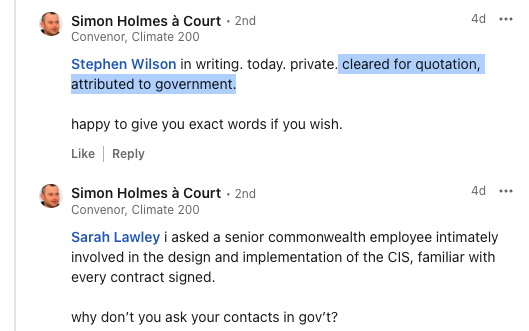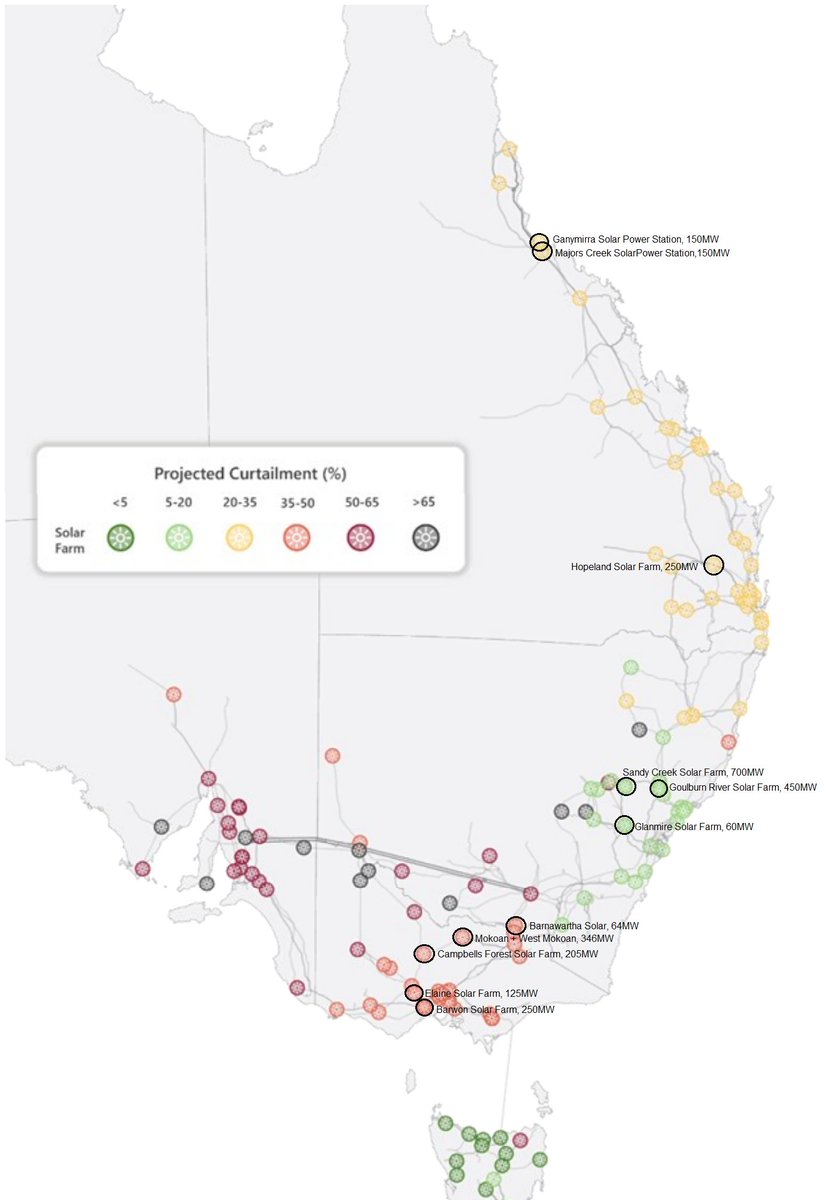As promised, there's a plot twist on this question about CIS funding curtailment.
The first 6GW of generation contracts of CIS did get funded for curtailment.
So @simonahac is dead wrong about this blanket claim.
But CIS is changing... maybe? 1/
The first 6GW of generation contracts of CIS did get funded for curtailment.
So @simonahac is dead wrong about this blanket claim.
But CIS is changing... maybe? 1/
https://twitter.com/FootnotesGuy/status/1945410154129973402

David Osmond has pointed this out, and I also know that Ben Beattie @EnergyWrapAU also discovered this.
The pro-forma contract for the upcoming round (closed, but not awarded, which is Round 4) removes the provision.
We're all in agreement there. 2/
The pro-forma contract for the upcoming round (closed, but not awarded, which is Round 4) removes the provision.
We're all in agreement there. 2/
https://x.com/DavidOsmond8/status/1945720113535373402
The critical clause that's changed is 3.9.
The "Notional Quantity" which is the volume on which they get paid the agreed unit price included Force Majeure Events in the Round 1 tender, but that's been removed in the contract for Round 4. 3/

The "Notional Quantity" which is the volume on which they get paid the agreed unit price included Force Majeure Events in the Round 1 tender, but that's been removed in the contract for Round 4. 3/


This change is only clear if you trace your way through all the equations and get confidence in them. As Ben and @DavidOsmond8 have done. But the contracts still explicitly include curtailment in the Force Majeure definition so it's confusing at a glance. 4/ 

Just to give you an idea, if you pass the contract to ChatGPT4 it gives you exactly the wrong answer. It still thinks that the revenue would be underwritten. 5/ 

If you ask it to step through the mathematical logic, it finds the right terms and definitions, but still comes up with the wrong answer.
This should be some kind of case study in the power and pitfalls of AI. 6/
This should be some kind of case study in the power and pitfalls of AI. 6/

I had to really walk it through... point out the negative sign in front of the relevant term in the equation, for it to finally arrive at the right answer.
I don't think it's an exaggeration to say that the contract could be made clearer. 7/

I don't think it's an exaggeration to say that the contract could be made clearer. 7/


So, the confusion is reflected in the Q&A responses that were published from the February application stages.
Someone asked the question on curtailment. In plain English.
And the answer from @DCCEEW was... "get legal advice".
What the....!??🤯🤯🤯🤯
8/
Someone asked the question on curtailment. In plain English.
And the answer from @DCCEEW was... "get legal advice".
What the....!??🤯🤯🤯🤯
8/

That's the first reason why I'm even more pissed off with the SHaC excuse being used by @simonahac.
His mates will tell him something with confidence and clarity about the future rounds that the department won't even say to a proponent in the official Q&A!
What snakes! 🐍 9/
His mates will tell him something with confidence and clarity about the future rounds that the department won't even say to a proponent in the official Q&A!
What snakes! 🐍 9/
So Simon goes and embarrasses himself in front of the LinkedIn energy crowd... Crowing with confidence, discarding all evidence... on behalf of his cowardly buddies who wouldn't dare mumble the same claim in their official capacities.
Disgraceful. 10/
Disgraceful. 10/
But there's another round of Q&A. The proponents have checked with lawyers. Who decoded the maths.
They asked to have the curtailment payment added back in again.
This settles, beyond any dispute, that the CIS did pay curtailment in the last round. 11/
They asked to have the curtailment payment added back in again.
This settles, beyond any dispute, that the CIS did pay curtailment in the last round. 11/

But it's the answer here that is massively consequential.
Proponents may submit a "commercial departure" to change the deal.
And AEMO promises they'll frown upon this. They'll mark it down on their clipboard.
Rightio. 12/
Proponents may submit a "commercial departure" to change the deal.
And AEMO promises they'll frown upon this. They'll mark it down on their clipboard.
Rightio. 12/

But here's the thing... That's completely non-binding. AEMO doesn't make the final decision. The Minister does. That's Chris Bowen.
They can say they don't want to change the documents, but at the end of the day, Bowen signs the cheques. 13/

They can say they don't want to change the documents, but at the end of the day, Bowen signs the cheques. 13/


So I think David Osmond's claim here is still wrong.
The CIS may well provide protection against curtailment. We will probably just never know about it. 14/
The CIS may well provide protection against curtailment. We will probably just never know about it. 14/
https://x.com/DavidOsmond8/status/1945738171226202491
What I can't get my head around is the supreme arrogance and idiocy of the public service in this. If they don't want to fund curtailment, make it concrete. Make it clear. Rule out that modification.
Why mince words, with this "get legal advice" bullshit? 15/
Why mince words, with this "get legal advice" bullshit? 15/
Do they think that some proponents will have incompetent lawyers, and not notice? Insane.
Again... because he's still hiding, Simon's mate is a snake and a coward. How dare he give SHaC an official "cleared" statement to bandy it on LinkedIn, but obfuscate in officialdom. 16/
Again... because he's still hiding, Simon's mate is a snake and a coward. How dare he give SHaC an official "cleared" statement to bandy it on LinkedIn, but obfuscate in officialdom. 16/

These are the lucky 6GW CIS winners in Round 1.
Their curtailment is underwritten by taxpayers.
Barwon, Elaine, Mokoan... solar farms expecting 30-50% curtailment... underwritten!
Imagine how pissed you'd be if you were waiting for the next round, and missed out!
17/

Their curtailment is underwritten by taxpayers.
Barwon, Elaine, Mokoan... solar farms expecting 30-50% curtailment... underwritten!
Imagine how pissed you'd be if you were waiting for the next round, and missed out!
17/


Or I think, much more likely, they'll all submit variations. Or hike their bid in floor price to cover that risk. I just can't see how the CIS achieves the aim of supporting the investment without one of those happening. 18/
What explains this?
Only the desire to make it undiscoverable. Obscure the truth, so everyone can believe what they want to, including SHaC.
This is a positive disaster for transparency, and makes the CIS a petri-dish for corruption. 19/
Only the desire to make it undiscoverable. Obscure the truth, so everyone can believe what they want to, including SHaC.
This is a positive disaster for transparency, and makes the CIS a petri-dish for corruption. 19/
The Minister has made @AEMO_Energy the administrator of the CIS, so that no Freedom Of Information claim can be made. And they never have to answer to Senate Estimates. The pro-forma can be modified. AEMO's assessment of merit will remain secret. And then... 20/
Chris Bowen will make the final decision.
That gives every wind and solar proponent both a strong argument, and powerful incentive, to persuade Chris Bowen himself to underwrite their project, like those before. 21/
That gives every wind and solar proponent both a strong argument, and powerful incentive, to persuade Chris Bowen himself to underwrite their project, like those before. 21/
And since AEMO's assesment of merit is just advice, and never discoverable, there's no reasonable way that Chris Bowen can be held to account for acting against it, and granting friends a favour, worth many millions, or billions of taxpayer dollars. 22/
This is absurd. I just can't see how that level of transparency is acceptable in a liberal democracy. I actually hope @simonahac agrees with me here.
I hope people of any/all stripes agree the CIS must change. 23/23
I hope people of any/all stripes agree the CIS must change. 23/23
• • •
Missing some Tweet in this thread? You can try to
force a refresh















